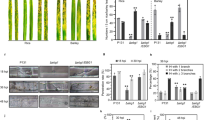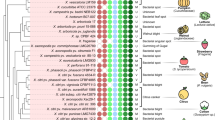Abstract
Myxobacterial predation on bacteria has been investigated for several decades. However, their predation on fungi has received less attention. Here, we show that a novel outer membrane β-1,6-glucanase GluM from Corallococcus sp. strain EGB is essential for initial sensing and efficient decomposition of fungi during predation. GluM belongs to an unstudied family of outer membrane β-barrel proteins with potent specific activity up to 24,000 U/mg, whose homologs extensively exist in myxobacteria. GluM was able to digest fungal cell walls efficiently and restrict Magnaporthe oryzae infection of rice plants. Genetic complementation with gluM restored the fungal predation ability of Myxococcus xanthus CL1001, which was abolished by the disruption of gluM homolog oar. The inability to prey on fungi with cell walls that lack β-1,6-glucans indicates that β-1,6-glucans are targeted by GluM. Our results demonstrate that GluM confers myxobacteria with the ability to feed on fungi, and provide new insights for understanding predator-prey interactions. Considering the attack mode of GluM, we suggest that β-1,6-glucan is a promising target for the development of novel broad-spectrum antifungal agents.
Similar content being viewed by others
Login or create a free account to read this content
Gain free access to this article, as well as selected content from this journal and more on nature.com
or
References
Munozdorado J, Marcostorres FJ, Garciabravo E, Moraledamunoz A, Perez J. Myxobacteria: moving, killing, feeding, and surviving together. Front Microbiol. 2016;7:781–781.
Keane R, Berleman JE. The predatory life cycle of Myxococcus xanthus. Microbiology. 2016;162:1–11.
Livingstone PG, Millard AD, Swain MT, Whitworth DE. Transcriptional changes when Myxococcus xanthus preys on Escherichia coli suggest myxobacterial predators are constitutively toxic but regulate their feeding. Microb Genom. 2018;4:e000152.
Evans AG, Davey HM, Cookson A, Currinn H, Cooke-Fox G, Stanczyk PJ, et al. Predatory activity of Myxococcus xanthus outer-membrane vesicles and properties of their hydrolase cargo. Microbiology. 2012;158:2742–52.
Morgan AD, MacLean RC, Hillesland KL, Velicer GJ. Comparative analysis of Myxococcus predation on soil bacteria. Appl Environ Microbiol. 2010;76:6920–7.
Latgé JP. The cell wall: a carbohydrate armour for the fungal cell. Mol Microbiol. 2007;66:279–90.
Mauch F, Mauchmani B, Boller T. Antifungal hydrolases in pea tissue: II. Inhibition of fungal growth by combinations of chitinase and β-1,3-glucanase. Plant Physiol. 1988;88:936–42.
Harman GE, Howell CR, Viterbo A, Chet I, Lorito M. Trichoderma species-opportunistic, avirulent plant symbionts. Nat Rev Microbiol. 2004;2:43–56.
Selitrennikoff CP. Antifungal proteins. Appl Environ Microbiol. 2001;67:2883–94.
Umeyama T, Kaneko A, Watanabe H, Hirai A, Uehara Y, Niimi M, et al. Deletion of the CaBIG1 gene reduces β-1, 6-glucan synthesis, filamentation, adhesion, and virulence in Candida albicans. Infect Immun. 2006;74:2373–81.
Gilbert NM, Donlin MJ, Gerik KJ, Specht CA, Djordjevic JT, Wilson CF, et al. KRE genes are required for β-1, 6-glucan synthesis, maintenance of capsule architecture and cell wall protein anchoring in Cryptococcus neoformans. Mol Microbiol. 2010;76:517–34.
Oliveira-GarciaE, Deising HB. Attenuation of PAMP-triggered immunity in maize requires down-regulation of the key β-1, 6-glucan synthesis genes KRE5 and KRE6 in biotrophic hyphae of Colletotrichum graminicola. Plant J. 2016;87:355–75.
Djonović S, Pozo MJ, Kenerley CM. Tvbgn3, a β-1, 6-glucanase from the biocontrol fungus Trichoderma virens, is involved in mycoparasitism and control of Pythium ultimum. Appl Environ Microbiol. 2006;72:7661–70.
Schwechheimer C, Kuehn MJ. Outer-membrane vesicles from Gram-negative bacteria: biogenesis and functions. Nat Rev Microbiol. 2015;13:605–19.
Berleman JE, Allen S, Danielewicz MA, Remis JP, Gorur A, Cunha J, et al. The lethal cargo of Myxococcus xanthus outer membrane vesicles. Front Microbiol. 2014;5:474.
Chaturvedi D, Mahalakshmi R. Transmembrane β-barrels: evolution, folding and energetics. BBA-Biomembranes. 2017;1859:2467–82.
Bishop RE. Structural biology of membrane-intrinsic β-barrel enzymes: Sentinels of the bacterial outer membrane. BBA-Biomembranes. 2008;1778:1881–96.
Pimentel D, McNair S, Janecka J, Wightman J, Simmonds C, O’connell C, et al. Economic and environmental threats of alien plant, animal, and microbe invasions. Agr Ecosyst Environ. 2001;84:1–20.
Glare T, Caradus J, Gelernter W, Jackson T, Keyhani N, Köhl J, et al. Have biopesticides come of age? Trends Biotechnol. 2012;30:250–8.
Bull CT, Shetty KG, Subbarao KV. Interactions between myxobacteria, plant pathogenic fungi, and biocontrol agents. Plant Dis. 2002;86:889–96.
Li Z, Ye X, Chen P, Ji K, Zhou J, Wang F, et al. Antifungal potential of Corallococcus sp. strain EGB against plant pathogenic fungi. Biol Control. 2017;110:10–17.
Hodgkin J, Kaiser D. Cell-to-cell stimulation of movement in nonmotile mutants of Myxococcus. Proc Natl Acad Sci USA. 1977;74:2938–42.
Stalhberger T, Simenel C, Clavaud C, Eijsink VG, Jourdain R, Delepierre M, et al. Chemical organization of the cell wall polysaccharide core of Malassezia restricta. J Biol Chem. 2014;289:12647–56.
Zhong K, Li X, Le X, Kong X, Zhang H, Zheng X, et al. MoDnm1 dynamin mediating peroxisomal and mitochondrial fission in complex with MoFis1 and MoMdv1 is important for development of functional appressorium in Magnaporthe oryzae. PLoS Pathog. 2016;12:e1005823.
Talbot NJ, Ebbole DJ, Hamer JE. Identification and characterization of MPG1, a gene involved in pathogenicity from the rice blast fungus Magnaporthe grisea. Plant Cell. 1993;5:1575–90.
Qi Z, Liu M, Dong Y, Zhu Q, Li L, Li B, et al. The syntaxin protein (MoSyn8) mediates intracellular trafficking to regulate conidiogenesis and pathogenicity of rice blast fungus. New Phytol. 2016;209:1655–67.
Valent B, Farrall L, Chumley FG. Magnaporthe grisea genes for pathogenicity and virulence identified through a series of backcrosses. Genetics. 1991;127:87–101.
Park DS, Sayler RJ, Hong YG, Nam MH, Yang Y. A method for inoculation and evaluation of rice sheath blight disease. Plant Dis. 2008;92:25–29.
Miller GL. Use of dinitrosalicylic acid reagent for determination of reducing sugar. Anal Chem. 1959;31:426–426.
Li Z, Wu J, Zhang B, Wang F, Ye X, Huang Y, et al. AmyM, a novel maltohexaose-forming α-amylase from Corallococcus sp. strain EGB. Appl Environ Microbiol. 2015;81:1977–87.
Perkins DN, Pappin DJ, Creasy DM, Cottrell JS. Probability-based protein identification by searching sequence databases using mass spectrometry data. Electrophoresis. 1999;20:3551–67.
Bi H, Ni X, Liu X, Iteku J, Tai G, Zhou Y, et al. A novel water-soluble β-(1 → 6)-D-glucan isolated from the fruit bodies of Bulgaria inquinans (Fries). Carbohyd Res. 2009;344:1254–8.
Xiu A, Kong Y, Zhou M, Zhu B, Wang S, Zhang J. The chemical and digestive properties of a soluble glucan from Agrobacterium sp. ZX09. Carbohyd Polym. 2010;82:623–8.
Zhou J, Li Z, Wu J, Li L, Li D, Ye X, et al. Functional analysis of a novel β-(1,3)-glucanase from Corallococcus sp. EGB containing a fascin-like module. Appl Environ Microbiol. 2017;83:e01016–17.
Ebbole DJ. Magnaporthe as a model for understanding host-pathogen interactions. Annu Rev Phytopathol. 2007;45:437–56.
Lipke PN, Ovalle R. Cell wall architecture in yeast: new structure and new challenges. J Bacteriol. 1998;180:3735–40.
Maddi A, Dettman A, Fu C, Seiler S, Free SJ. WSC-1 and HAM-7 are MAK-1 MAP kinase pathway sensors required for cell wall integrity and hyphal fusion in Neurospora crassa. PLoS ONE. 2012;7:e42374.
Gerth K, Jansen R, Reifenstahl G, Höfle G, Irschik H, Kunze B, et al. The myxalamids, new antibiotics from Myxococcus xanthus (Myxobacterales). J Antibiot. 1983;36:1150–6.
Martinez-Canamero M, Munoz-Dorado J, Farez-Vidal E, Inouye M, Inouye S. Oar, a 115-kilodalton membrane protein required for development of Myxococcus xanthus. J Bacteriol. 1993;175:4756–63.
Hillesland KL, Lenski RE, Velicer GJ. Ecological variables affecting predatory success in Myxococcus xanthus. Microb Ecol. 2007;53:571–8.
Zhou XW, Li SG, Li W, Jiang DM, Han K, Wu ZH, et al. Myxobacterial community is a predominant and highly diverse bacterial group in soil niches. Environ Microbiol Rep. 2014;6:45–56.
Dahm M, Brzezinska AJ, Wrótniak-Drzewiecka W, Golinska P, Rozycki H, Rai M. Myxobacteria as a potential biocontrol agent effective against pathogenic fungi of economically important forest trees. Dendrobiology. 2015;74:13–24.
Hagan CL, Silhavy TJ, Kahne D. β-Barrel membrane protein assembly by the Bam complex. Annu Rev Biochem. 2011;80:189–210.
Wenz L-S, Qiu J, Becker T, Wiedemann N. Biogenesis and folding of β-barrel membrane proteins. Cell Cycle. 2014;13:169–70.
Reynolds CM, Ribeiro AA, McGrath SC, Cotter RJ, Raetz CR, Trent MS. An outer membrane enzyme encoded by Salmonella typhimurium lpxR that removes the 3′-acyloxyacyl moiety of lipid A. J Biol Chem. 2006;281:21974–87.
Que-Gewirth NL, Karbarz MJ, Kalb SR, Cotter RJ, Raetz CR. Origin of the 2-amino-2-deoxy-gluconate unit in Rhizobium leguminosarum lipid A. Expression cloning of the outer membrane oxidase lpxQ. J Biol Chem. 2003;278:12120–9.
Gómez-Santos N, Glatter T, Koebnik R, Świątek-Połatyńsk M A, Søgaard-Andersen L. A TonB-dependent transporter is required for secretion of protease PopC across the bacterial outer membrane. Nat Commun. 2019;10:1360-1377.
Wd Boer, Folman LB, Summerbell RC, et al. in a fungal world: impact of fungi on soil bacterial niche development. FEMS Microbiol Rev. 2005;29:795–811.
Swain DM, Yadav SK, Tyagi I, Kumar R, Kumar R, Ghosh S, et al. A prophage tail-like protein is deployed by Burkholderia bacteria to feed on fungi. Nat Commun. 2017;8:404.
Trunk K, Peltier J, Liu YC, Dill BD, Walker L, Gow N, et al. The type VI secretion system deploys antifungal effectors against microbial competitors. Nat Microbiol. 2018;3:920–31.
Synytsya A, Novák M. Structural diversity of fungal glucans. Carbohyd Polym. 2013;92:792–809.
Fesel PH, Zuccaro A. β-glucan: crucial component of the fungal cell wall and elusive MAMP in plants. Fungal Genet Biol. 2016;90:53–60.
Klis FM, Boorsma A, De Groot PW. Cell wall construction in Saccharomyces cerevisiae. Yeast. 2006;23:185–202.
Osumi M. The ultrastructure of yeast: cell wall structure and formation. Micron. 1998;29:207–33.
Tonon C, Guevara G, Oliva C, Daleo G. Isolation of a potato pcidic 39 kDa β-1, 3-glucanase with antifungal activity against Phytophthora infestans and analysis of its expression in potato cultivars differing in their degrees of field resistance. J Phytopathol. 2002;150:189–95.
Scott JH, Schekman R. Lyticase: endoglucanase and protease activities that act together in yeast cell lysis. J Bacteriol. 1980;142:414–23.
Karasuda S, Tanaka S, Kajihara H, Yamamoto Y, Koga D. Plant chitinase as a possible biocontrol agent for use instead of chemical fungicides. Biosci Biotechnol Biochem. 2003;67:221–4.
Fridlender M, Inbar J, Chet I. Biological control of soilborne plant pathogens by a β-1, 3 glucanase-producing Pseudomonas cepacia. Soil Biol Biochem. 1993;25:1211–21.
Benhamou N, Broglie K, Broglie R, Chet I. Antifungal effect of bean endochitinase on Rhizoctonia solani: ultrastructural changes and cytochemical aspects of chitin breakdown. Can J Microbiol. 1993;39:318–28.
Acknowledgements
We would like to thank Prof. Xiaohua Mao and Prof. Huiqiang Lou for generously providing strains Myxococcus xanthus DK1622 and Neurospora crassa, Prof. Yifa Zhou for generously providing the β-1,6-glucan BIWP2, Prof. Yuezhong Li for the kind suggestions for gene knockout, Prof. Yufeng Yao and Prof. Daniel Wall and Prof. Ruifu Zhang for helpful manuscript suggestions. We are grateful to Prof. Josef Voglmeir for revising the manuscript. This work was supported by the Major State Basic Research Development Program of China (973 program, no. 2015CB150502), the National Natural Science Foundation of China (No. 31570059 and 31700054), the Postdoctoral Science Foundation of China (No. 2016M591859) and Jiangsu Agricultural science and technology innovation fund (CX(18)1003).
Author information
Authors and Affiliations
Corresponding authors
Ethics declarations
Conflict of interest
The authors declare that they have no conflict of interest.
Additional information
Publisher’s note: Springer Nature remains neutral with regard to jurisdictional claims in published maps and institutional affiliations.
Rights and permissions
About this article
Cite this article
Li, Z., Ye, X., Liu, M. et al. A novel outer membrane β-1,6-glucanase is deployed in the predation of fungi by myxobacteria. ISME J 13, 2223–2235 (2019). https://doi.org/10.1038/s41396-019-0424-x
Received:
Revised:
Accepted:
Published:
Issue Date:
DOI: https://doi.org/10.1038/s41396-019-0424-x
This article is cited by
-
Glucanase Gene of Trichoderma; New Strategy for the Management of Root Rot Disease in Chili
Journal of Soil Science and Plant Nutrition (2024)
-
Antifungal characterizations of a novel endo-β-1,6-glucanase from Flavobacterium sp. NAU1659
Applied Microbiology and Biotechnology (2024)
-
Myxobacteria restrain Phytophthora invasion by scavenging thiamine in soybean rhizosphere via outer membrane vesicle-secreted thiaminase I
Nature Communications (2023)
-
Predation of oomycetes by myxobacteria via a specialized CAZyme system arising from adaptive evolution
The ISME Journal (2023)
-
A myxobacterial GH19 lysozyme with bacteriolytic activity on both Gram-positive and negative phytopathogens
AMB Express (2022)



